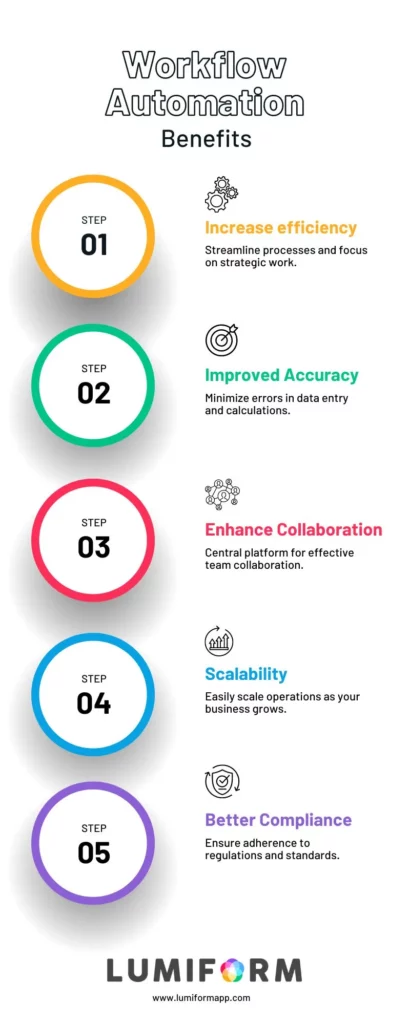Workflow automation integrates technology to streamline and optimize your organization’s processes. This guide focuses on how automation tools can significantly enhance your operational efficiency by reducing manual tasks and errors. As your organization seeks to innovate and improve workflows, understanding the strategic implementation of automation will be crucial.
What is workflow automation?
Workflow automation involves the use of software and tools to automate complex business processes. It is designed to minimize manual intervention, ensure consistency in task execution, and enhance overall efficiency. By taking over repetitive tasks, automation software allows your team to focus on more critical, value-added activities. It seamlessly integrates with existing systems to capture data, route information, and trigger actions based on predefined rules.
From improving speed and accuracy to enhancing transparency across operations, workflow automation can transform key aspects of your business. This capability not only supports better scalability but also enables more strategic decision-making by providing timely and accurate data insights.
Understanding workflow automation
Workflow automation is a pivotal tool that enhances operational efficiency by systematically managing and improving business processes. This section delves into the critical aspects of implementing and measuring the impact of workflow automation within your organization.
Implementing workflow automation: Step-by-step guide
Implementing workflow automation requires a structured approach to integrate technology seamlessly into your existing processes. The first step is to identify the repetitive tasks that are candidates for automation. Analyzing these tasks helps pinpoint where automation can have the most significant impact. Next, select the right automation tool that fits the specific needs of your business. It’s essential to choose a platform that is scalable, user-friendly, and compatible with your current systems.
Once the tool is selected, map out the workflow clearly, defining each step, decision point, and outcome. This mapping should include input from all stakeholders to ensure that the automated process aligns with business objectives and user needs. After configuring the workflow in the automation tool, test it thoroughly to resolve any issues before going live. Finally, train your team on how to use the new system effectively, emphasizing the benefits and changes to their daily work routines.
Measuring the impact of automation
Effectively assessing the impact of workflow automation is vital for validating its benefits and identifying areas for enhancement. Here are the key steps to measure its effectiveness:
- Set Clear Objectives: Before implementing automation, define specific, measurable goals such as reducing process times, decreasing error rates, or enhancing customer satisfaction.
- Monitor Key Performance Indicators (KPIs): Establish metrics that will help track the success of the automated workflows. Regular monitoring of these KPIs post-implementation is crucial to evaluate the automation’s effectiveness.
- Gather Employee Feedback: Collect insights from team members who use the automated processes. Their feedback is invaluable for understanding user satisfaction and pinpointing potential areas for process refinement.
- Review Process Improvements: Analyze the automated workflows to see if they meet the initial objectives. Consider adjustments based on the outcomes and feedback to optimize the processes further.
- Document Changes and Results: Keep a detailed record of before-and-after scenarios, including quantitative and qualitative data. This documentation will help in making data-driven decisions and showcase the value added through automation.
Harness the power of workflow automation
Adopting workflow automation is more than just a technological upgrade; it’s a strategic enhancement to your organization’s operations. This section explores the transformative potential of workflow automation and how it can be leveraged to drive significant improvements across various facets of your business. From streamlining daily tasks to fostering a culture of innovation and efficiency, workflow automation provides a robust foundation for your team to excel and thrive in a competitive landscape.
Workflow automation applied to specific industries
The general benefits of workflow automation present themselves in specific ways depending which industry is involved. Examples of industries that get the most out of workflow automation software include:
- Construction
- Manufacturing
- Gastronomy
- Retail
- Healthcare
These are all fields where day-to-day operations involve lots of repetitive tasks as well as tasks which need to be done very specifically, both to maintain quality and to ensure worker safety. This makes them excellent candidates for workflow automation.
Workflow automation in construction
Construction businesses work faster, more safely, and more profitably when they use workflow automation software. On a construction site, there are many tasks happening at the same time and it’s important to take the appropriate safety measures before each one. For example, you can use your workflow software to codify the equipment maintenance necessary before your workers operate heavy machinery.
Workflow management software is key to making sure your workers all have their tasks and roles clearly defined, making it easy for them to see each other’s schedules and coordinate, and keeping to an often tight project schedule. You can also use it to streamline the way you approach hazard assessments and improve compliance with applicable (especially OSHA) regulations.
Finally, workflow software is useful for managing contracts and billing. With several people on a construction crew and potentially changing project requirements, you’ll be processing requests and ordering materials a lot. Workflow automation enables you to generate templates you can use to digitize all this paperwork, so it’s easier to manage and store. And this way, you won’t miss any payments.
Workflow automation in manufacturing
Manufacturing business benefit heavily from workflow automation as a form of quality control. Digitally generated checklists that standardize the way your workers perform tasks and inspect products make finding defects much simpler and help you flag issues before production is complete. The same administrative functions that help you manage construction workers help you stick to a quality management plan.
Manufacturing is also highly specific work, and automated systems help make sure that parts are used correctly and efficiently. Not having to throw out or replace parts that were used incorrectly means less waste, which means more production and revenue.
Workflow automation in gastronomy
Like construction and manufacturing, gastronomy businesses are subject to lots of regulations, particularly since they serve customers. That means they need to pay attention to food safety as well as workplace safety.
Workflow automation helps your food business assign and track food safety measures and measure the condition of essential equipment like freezers and refrigeration units. Ensure your workers don’t forget to wear their PPE before handling food by including this in your food safety checklist.
Performing al these inspections with workflow automation software instead of manually doesn’t just make the process faster, it gives you an easy means of documenting everything, since data is saved automatically. Documentation is important for process improvement, but also for legal proof that you adhere to safety guidelines.
Workflow automation in retail
The specific benefits of workflow automation in retail come through in inventory management and online sales. Sales workflows are perfect for automation because it’s generally a repeated cycle where customers place orders, the order is processed, and then the order is confirmed.
Instead of manually checking for and responding to orders, put workflows in place that alert you whenever an order is placed and send confirmations to customers. Then you can automate further updates to customers which trigger once products ship and are delivered.
Workflow software also streamlines inventory management for retail businesses. By conducting inventory checks and providing your workflow platform with data, you can set thresholds for automatic reorders, ensuring you never have to tell customers “sorry, we’re out of that”. Inventory management software that reacts automatically to changes in your stock helps you maintain product availability without over-ordering.
Workflow automation in healthcare
Workflow management software streamlines a lot of administration in healthcare and helps you care for patients more efficiently. From booking and scheduling appointments to the hospital experience, patients appreciate the convenience that automated services provide.
For example, online appointment booking is a simple feature that makes 68% of patients more likely to set up an appointment with you. Online appointments are also easier for your business to keep a record of.
When it comes to interacting with patients, there can be a lot of paperwork involved. You need to make sure that doctors and medical professionals cover everything when they’re speaking with patients, which is why it’s not a good idea to rely on individual styles of record-keeping. These can be inconsistent and they cannot be reused.
Instead, pre-generated templates that follow the SOAP note format ensure you remember to ask all the important questions. It presents one standardized format that all your employees use, so it introduces consistency in record-keeping. And unlike a paper form, you can reuse these templates as many times as you have new patients, as well as easily find their data for subsequent visits.
Benefits of workflow automation for your team
Implementing an automation tool within your organization brings numerous advantages that can transform how your team operates. Here are some of the key benefits your team can experience:
- Increased Efficiency: Automation streamlines processes by eliminating redundant tasks and reducing the time required to complete each process. This allows your team to focus on more strategic work that adds value to the business.
- Improved Accuracy: Automated workflows reduce the likelihood of human error, ensuring that tasks are performed consistently and accurately. This is crucial in areas like data entry, calculations, and report generation.
- Enhanced Collaboration: Workflow automation tools often come with features that enhance communication and collaboration among team members. By providing a central platform for information sharing, your team can work more cohesively and respond quicker to project demands.
- Scalability: As your business grows, the ability to scale operations effectively becomes essential. Automation makes it easier to adjust processes and increase workloads without the need to proportionally increase your staff.
- Better Compliance: Automated systems help maintain compliance with industry regulations and standards by enforcing consistent application of rules and procedures. This reduces the risk of non-compliance penalties and ensures that audits are passed more smoothly.
- Increased Job Satisfaction: By reducing mundane tasks and giving employees more engaging work, automation can help increase job satisfaction and reduce turnover. Employees feel more valued when they can contribute to more significant projects and initiatives.


